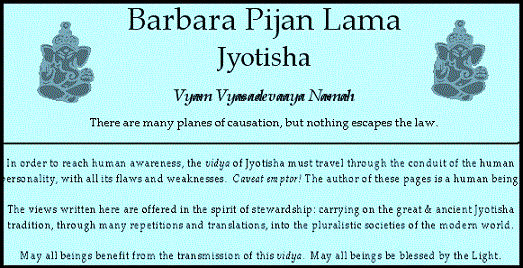

Vimshottari Dasha - Rashi - Gochara - Bhava - Graha - Ratna - Nakshatra - Amsha - Karaka - Varga - Bala
- Traditional Jyotishavidya Sacred Jewels Ratna for Budha
- Busy Budha reaches maturity = age 32
- [energizing-identifying lagnesha for Kanya indriya-lagna]
- [energizing-identifying lagnesha for Mithuna indriya-lagna]
- BPHS Vimshottari Mahadasha of Budha
- BP Lama commentary Budha-Mahadasha
- [Budha in bhava-1] [dikbala]
- [Budha in bhava-2]
- [Budha in bhava-3] [svabhava]
- [Budha in bhava-4]
- [Budha in bhava-5]
- [Budha in bhava-6] [svabhava]
- [Budha in bhava-7]
- [Budha in bhava-8]
- [Budha in bhava-9]
- [Budha in bhava-10]
- [Budha in bhava-11]
- [Budha in bhava-12]
- [Budha-Mesha]
- [Budha-Urisha]
- [Budha-Mithuna] [svakshetra]
- [Budha-Karkata]
- [Budha-Simha]
- [Budha-Kanya] [uchcha] [svakshetra] [mulatrikona if between 16-20 deg]
- [Budha-Tula]
- [Budha-Vṛścika}
- [Budha-Dhanus]
- [Budha-Makara]
- [Budha-Kumbha]
- [Budha-Meena] [nīcha if within 16-20 deg]

OM hrim krom aim grhanathaya budhaya svaha
nīcha = 15-20 degrees
बुध budha
Professor Budha
Parya - Parthya - Pana - Paranaya
विद् vid = declare, inquire, announce, report, explain [wit]
ज्ञ jña = thinker [said also of Mangala]
बोधन bodhana = instructing, informing; causing to awake, arousing
कुमार kumāra = boy, youth, groom, prince
प्रहर्षुल pra-harṣula = arousing, enrapturing
सोमपुत्र soma-putra = child of Chandra
नक्षत्रपति nakṣatra-pati = nakshatra master
occupies
Mina - Minamatsya - Matsya
Machchu
अन्त्य antya = end, final, terminal, funeral
झष jhaṣa = large fish
पृथुरोमन् pṛthuroman = fish, having broad scales
तिमि timi = whale
Mercury the Merchant
Ἑρμῆς ὁ Τρισμέγιστος = Hermes Trimegistus
Thoth
Mercurius ter Maximus
Merx - Mark - Merch
sMargara - sMarjali
Marketa - Margareta
Enki
Nabu - Neba
Sabgu - Borsippa
Odin Woden = Wednesday
resides in
Piscetis
Ichthys
Fish
intuitive cunning * kenning

EXAMPLES
[Budha in bhava-1] [nīcha] [potentially nicha-bhanga if yuti uchcha-Shukra]
[dikbala]
[bargaining-balancing jaya-pati for Meena indriya-lagna] [homebound-anchoring bandhesha for Meena indriya-lagna]
check Guru and Guru-drishti for defining source of Budha's abstract imagining worldview
intuitive narrative of body, self, identity
[Budha in bhava-2] [nīcha] [potentially nicha-bhanga if yuti uchcha-Shukra]
[creative-displaying vidya-pati for Kumbha indriya-lagna] [mysterious-transformative randhresha for Kumbha indriya-lagna]
check Guru and Guru-drishti for defining source of Budha's abstract imagining worldview
intuitive narrative of values-fulfillment, naatural resources
-
Violet Flame 1939-2009 Elizabeth Clare Prophet [mysterious-revealing Andromeda-4] + [asta-Shani-yuti-Surya]
[Budha in bhava-3] [svabhava] [nīcha]
[potentially nicha-bhanga if yuti uchcha-Shukra]
[inimical-medicating rogesha for Makara - Draco indriya-lagna] [believing-principled dharmesha for Makara - Draco indriya-lagna]
check Guru and Guru-drishti for defining source of Budha's abstract imagining worldview
mental response to human problematics, expressed via messaging and explanation
intuitive narrative of cohort, siblings, announcements, discussions
-
Dialogue 1347-1380 St. Catherine of Siena [governing-organizational Revatī-2] + [Mangala-yuti-Surya]
-
UK-Queen 1926-2022 Elizabeth-2 [diplomatic-brokering Uttarabhadra-3]
-
Knowledge of Higher Worlds 1861-1925 Rudolf Steiner [rhythmic-ancestral Purvabhadra-4]
[Budha in bhava-4] [nīcha] [potentially nicha-bhanga if yuti uchcha-Shukra]
[balancing-bargaining yuvati-pati for Dhanus - Haya indriya-lagna] [dutiful-commanding karmesha for Dhanus - Haya indriya-lagna]
check Guru and Guru-drishti for defining source of Budha's abstract imagining worldview
intuitive narrative of parents, homeland, roots, routine, ritual * discusses the mother-figure,
-
Annunciation 1452-1519 logic Leonardo daVinci [profitable-friendly Revatī-3] [Budha-yuti-Chandra]
-
Out on a Limb 1934- drama-esoterica Shirley MacLaine [corporate-organizational Revatī-2] [nicha-Budha-4 parivartamsha + mutual exchange Guru-10]
[Budha in bhava-5] [nīcha] [potentially nicha-bhanga if yuti uchcha-Shukra]
[mysterious-revealing randhresha for Vṛścika indriya- lagna] [friendly-economic vriddhi-pati for Vṛścika indriya- lagna]
check Guru and Guru-drishti for defining source of Budha's abstract imagining worldview
intuitive narrative of drama, politics, creativity
- POTUS-pair-37 Watergate 1912-1993 Pat Ryan Nixon [philosophical-believing Revatī-1] [nicha-asta-Revati-Budha-yuti-Surya-Andromeda]
***
-
Flowers of Evil 1821-1867 symbolist poet Charles Baudelaire [poetic-romantic Andromeda-1] [Surya-yuti-Kuja] + [Guru-yuti-Shani] + [Shukra-yuti-Budha-nicha-bhanga] (5, poetry)
-
Japan-Emperor1901-1989 Showa Hirohito [visionary-conceptual Revatī-4] [navamsha Budha-Meena-nicha] [vargottamsha] [Atmakaraka]
[Budha in bhava-6] [nīcha] [potentially nicha-bhanga if yuti uchcha-Shukra] [svabhava]
[Vimala Yoga] [svabhava]
[philosophical-doctrinal dharmesha for Tulā indriya-lagna] [contemplative-isolating vyaya-pati for Tulā indriya-lagna]
check Guru and Guru-drishti for defining source of Budha's abstract imagining worldview
[conceptually imagined arguments] [dreamlike accusations] [intuitive handling of conflict]
-
POTUS-18 Civil War 1822-1885 Ulysses S. Grant [visionary-conceptual Revatī-4] [navamsha Budha-Meena-nicha] [vargottamsha] + [Atmakaraka] [nīcha-Budha-yuti-Shukra-uchcha]
[Budha in bhava-7] [nīcha] [potentially nicha-bhanga if yuti uchcha-Shukra]
[energizing-identifying lagnesha for Kanya indriya-lagna] [dutiful-hierarchical karmesha for Kanya indriya-lagna]
check Guru and Guru-drishti for defining source of Budha's abstract imagining worldview
intuitive narrative of relationships, contracts, deals
[potentially nicha-bhanga if yuti uchcha-Shukra]
[historical-evaluating dhanesha for Simha indriya-lagna] [profitable-friendly labha-pati for Simha indriya-lagna]
check Guru and Guru-drishti for defining source of Budha's abstract imagining worldview
intuitive narrative of mysteries, unexpected force, sudden change
-
Chariots of Fire 1955-1997 Dodi Al-Fayed [corporate-organizational Revatī-2] [Budha-8 parivartamsha Guru]
[Budha in bhava-9] [nīcha] [potentially nicha-bhanga if yuti uchcha-Shukra]
[busy-messaging vikrama-pati for Karkata indriya lagna] [retreating-contemplative vyaya-pati for Karkata indriya lagna]
check Guru and Guru-drishti for defining source of Budha's abstract imagining worldview
[narrative of intuitive perception] [dreamlike instructions] [abstract confessional testimony] [clairsentient explanations] [father may talk devotionally]
-
POTUS-03 Declaration of Independence 1743-1826 Thomas Jefferson [negotiating-arranging Andromeda-3]
-
UK-Prince 2018- Louis Arthur Mountbatten-Windsor [bargaining-arranging Andromeda-3]
***
-
El Castilo Interior 1515-1582 St. Teresa de Avila [visionary-conceptual Revatī-4] [navamsha Budha-Meena-nicha] [vargottamsha] [Budha nīcha-bhanga ] + [Surya-yuti-Shukra-uchcha]
[Budha in bhava-10] [nīcha] [potentially nicha-bhanga if yuti uchcha-Shukra] '
[energizing-identifying lagnesha for Mithuna indriya-lagna] [homebound-anchoring bandesha for Mithuna indriya-lagna]
check Guru and Guru-drishti for defining source of Budha's abstract imagining worldview
intuitive narrative of leadership, the burden of responsibility, maintenance of the social order
-
Theory of Relativity 1879-1955 Physics Albert Einstein [diplomatic-balancing Andromeda-3] + [Budha nīcha-bhanga] [Budha-yuti-Surya] + [uchcha-Shukra-yuti-Shani]
[Budha in bhava-11] [nīcha] [potentially nicha-bhanga if yuti uchcha-Shukra]
[collecting-evaluating dhanesha for Urisha indriya-lagna] [witty-creative vidya-pati for Urisha indriya-lagna]
check Guru and Guru-drishti for defining source of Budha's abstract imagining worldview
Dhanayoga = Budha-11 rules 2]
...
intuitive narrative of economy, community, naetwork
[Budha in bhava-12] [nīcha] [potentially nicha-bhanga if yuti-Shukra]
[busy-collaborative sahaja-pati for Mesha indriya-lagna] [inimical-distrusting rogesha for Mesha indriya-lagna]
check Guru and Guru-drishti for defining source of Budha's abstract imagining worldview
[visionary narrative of clairsentient intuition] [conceptual articulation of symbolic messages]
-
Homeopathy 1755-1843 Dr. Samuel Hahnemann [matching-aligning Andromeda-3] [Chandra-yuti-Surya] + [Budha-yuti-Ketu]
-
POTUS-07 Indian Removal 1767-1845 Andrew Jackson [deal-making Uttarabhadra-3] + [Surya-yuti-Shukra-uchcha]
***
-
Russ-Empress 1729-1796 Noble Maidens Catherine the Great [visionary-conceptual Revatī-4] [navamsha Budha-Meena-nicha] [vargottamsha] [Atmakaraka] [nīcha-Budha-12 parivartamsha Guru-3]
intuitively explaining vague conceptual dreamlike visions
Nicha-bhanga in kendra
- any occurence of nicha-Budha is potentially nicha-bhanga if Budha yuti uchcha-Shukra in kendra
Example = Kendra Karmasthana
-
POTUS-07 Indian Removal 1767-1845 Andrew Jackson [deal-making Uttarabhadra-3] + [Surya-yuti-Shukra-uchcha]
-
Theory of Relativity 1879-1955 Physics Albert Einstein [diplomatic-balancing Andromeda-3] + [Budha nīcha-bhanga] [Budha-yuti-Surya] + [uchcha-Shukra-yuti-Shani]
Budha's messaging output =
filtered through the intuitive faith of [Guru-Meena]
When Professor Budha occupies Guru's rashi of Meena-Antya, the Kumara's detailed analytical communicative style becomes nebulized by the privately guiding, wholistic, symbolic, abstractly understanding [Guru-Meena] filter.
Register misalignment and genre mismatch
Replacing small, specific details with big, general impressions
Nicha-Budha may be challenged to detect and apply the socially appropriate linguistic register in gesture, speech, and writing.
Nicha-Budha may speak with excess formality when a casual register is being used by others in the language environment. For example, within a friendly group, rather than say "sorry", naicha-Budha may say "indeed that is most regrettable".
When a materialistic, logically ordered, scientific or scholarly register is required, naicha-Budha may substitute a dreamlike, poetic, metaphorical narrative.
In an academic setting when presenting research, naicha-Budha may lapse into a wandering personal reflection on unrelated topics.
When a specific question would be conventionally expected to produce a factually detailed answer, naicha-Budha may respond with a visionary concept, abroad generalization, or a zen koan.
Register alignment to Meena Environments
There is one communicative social register to which nicha-Budha is pre-attuned. That is the Meena world of private spiritual guidance, the realms of inchoate understanding, the mystical, the meditative, the interior, the intuitive, and fields of non-verbal or scarcely verbal wholistic perception. Teaching psychics found here.
-
Dialogue 1347-1380 St. Catherine of Siena [governing-organizational Revatī-2] + [Mangala-yuti-Surya]
-
El Castilo Interior 1515-1582 St. Teresa de Avila [visionary-conceptual Revatī-4] [navamsha Budha-Meena-nicha] [vargottamsha] [Budha nīcha-bhanga ] + [Surya-yuti-Shukra-uchcha]
-
Knowledge of Higher Worlds 1861-1925 Rudolf Steiner [rhythmic-ancestral Purvabhadra-4]
-
Violet Flame 1939-2009 Elizabeth Clare Prophet [mysterious-revealing Andromeda-4] + [asta-Shani-yuti-Surya]
Busy Budha feels neutral toward His landlord, benevolent Brihaspati
-
However, Guru treats His tenant Lord Budha as a satrugraha - enemy.
In the rashi of Minamatsya, budha's characteristic detailed verbal logic tends to be drowned in Meena's streaming, undulating, indistinct, deep-sea swells of inspirational hope.
Jack of all Trades, master of None
Imaginative Meena-Budha may lack denotative discrimination in vocabulary and verbal register
[nīcha] Budha does not lack articulatory power.
Barring harsh or heavily burdened drishti, especially from Shani, the Kumara's capacity for enunciation is normally unimpeded.
However, abrilliant explanation delivered by the [nīcha] Budha may be laced with register-inappropriate language, such as expletives. The vulgarities of street speech may mingle with the refined distinctions of academic discourse.
Blank Abstraction
This winding, poetic mode of communication may feel like a dive into the deep seas of ancient meaning. Or, it may be so laced with flights of fancy, so permeated with high concept or childlike imagination, that only a committed audience may be able to follow along.
Indiscriminate speech
[nīcha] Budha often has a bit of a potty-mouth, which indiscriminately mixes snippets of tavern-talk with the high lexicon of conceptual thought.
-
Flowers of Evil 1821-1867 symbolist poet Charles Baudelaire [poetic-romantic Andromeda-1] [Surya-yuti-Kuja] + [Guru-yuti-Shani] + [Shukra-yuti-Budha-nicha-bhanga] (5, poetry) Baudelaire remains a celebrated poet; nevertheless, in his own day, the coarse vulgarity of his descriptions, and his love paeans to Parisian prostitutes, were considered deeply offensive to bourgeois sensibilities.
-
Theory of Relativity 1879-1955 Physics Albert Einstein + [Budha nīcha-bhanga] [Budha-yuti-Surya] + [uchcha-Shukra-yuti-Shani]. Highly praised-and-prized ability to explain abstractions of conceptual physics. However, as his theories developed, Einstein performed little of his own mathematical calculation -- leaving that technical task to others, especially graduate assistants. AE was famous for his register-misaligned vulgar jokes.
By contrast, [uchcha-Budha]-Kanya is sharply discriminating in word choices, and tends to utilize the socially appropriate register.
Inspiration [Guru] vs. explanation [Budha]
- wisdom comes via the otherworldly in-breath * inspiration
- some challenges of speech on the this-worldly out-breath * explanation
Leaps of faith vs. stepwise chain of facts
Emitted by [nīcha] Budha, instructions often lack the // scaffolding // necessary to follow a series of logical steps. Rather, meena-Budha [unless nicha-bhanga] may tend to broadly assert visionary truths. The power of the poetic imagination may demand either acquiescence or denial with little use of critical thinking.
Nicha-Budha statements may be correct individually, but the chain of reasoning that is normally used to arrive at rational conclusions has often lapsed in several places. The lacunae are filled with Meena-ish imagination or intuitive dreams.
-
POTUS-pair-37 Watergate 1912-1993 Pat Ryan Nixon [philosophical-believing Revatī-1] [Surya-yuti-Budha-nicha-asta] PRN's [nīcha] Budha = PRN did not ask logical questions about Dick Nixon's increasingly paranoid claims, naor did she challenge his wrongdoing counselors [Budha counsel].
In substitution for the expected reasoning steps leading to a sensible conclusion, [nīcha] Budha takes a leap of faith [Guru]. [nīcha] Budha freely mixes data from the material world (the normal province of Budha) with data from the world of the imagination [Guru].
If the audience is aware of the special nature of the [nīcha] Budha's communicative methods, and the audience knows that this agent freely mixes information from the two worlds without identifying either source - so that imagination is made to sound material and material is made to sound imaginative - then the communication may be quite engaging.
However, the communications of [nīcha] Budha may not be as easily understood in the modern world, where mixing beliefs with facts is generally considered evidence of woolly thinking.
transcendence, transference, transition
Mental traffic [Budha] moving rapidly across the bridge from earthward material plane to heavenward astral plane [Meena].
Meena, the dreamlike rashi of all-encompassing, all-inclusive Guru, can welcome any graha EXCEPT Budha.
Budha the chatty conversational mentalizer develops several rather problematic traits in quiet, reflective Meena. Weakness related to any task that requires detailed, earth-bound stepwise argumentation, explanation, instruction. However, all of the problematics have partial solutions, including the best medicine which is self-knowledge.
jump to conclusions
Expands the reflecting pool [Meena] of the mentality, while generating [Guru] a discourse [Budha] of spiritual perception that may be rather illogical because it takes leaps-of-faith [Guru] over the expected sequential steps in the explanatory, instructional argument [Budha].
Because the concepts tend to overwhelm the details , budha-Meena is usually a capable inspirational preacher or Guru-type believing proselyte.
Yet, budha-Meena is not usually a clearly articulate trainer, explainer, instructor, report-writer, documenter, or messenger. May be an imaginative religious evangelist.
-
Out on a Limb 1934- drama-esoterica Shirley MacLaine [corporate-organizational Revatī-2] [nicha-Budha-4 parivartamsha + mutual exchange Guru-10] SM has written many books, hosted discussions and conferences, and and offered countless interviews. Dramatic scripts are usually executed with precision. However, when off-script, the claims made in her autobiographical writings are often deprecated, due to fuzzy-thinking.
A promoter of theory and big picture view. Inspirational and divinely poetic. Yet unless there is planetary support from Shani's "common sense" Budha-Meena may be missing the communicatively essential "operational" details.
May also be missing a specified testing methodology, or missing ability to articulate the logic of research methods. However, the typical nicha-Budha // skipping steps // in the logic does not in any way detract from the potential brilliance or ultimate truth of Budha's final announced conclusions.
Meena-Budha is blessed with a mentality that benefits from getting articulatory assistance with explanatory reasoning such as presentation of diagrams, charts, programmatic instructions, computations, and methodologies (or any sort of -ology).
If Budha-Meena can obtain the helpful technical support that can help clarify and complete their reasoning process in a more "down to Earth" fashion, then their conclusions may be celebrated as inspirational, spiritual uplifting, and ultimately true. It is important for all involved to appreciate that the Budha-Meena conclusions are often very true
Yet without the operational explanatory steps, attributions, and tested details, one may be tempted to go out on a limb and make seemingly wild assertions or prophetic predictions that collapse, causing the legendary indignity of the [nīcha] Budha.
Indignity of insights = Budha lacking "common sense" support from Shani
-
Out on a Limb 1934- drama-esoterica Shirley MacLaine [corporate-organizational Revatī-2] [nicha-Budha-4 parivartamsha + mutual exchange Guru-10] SM became a public exponent of alternative history narratives. Although accepted by a subculture of her audience, these envisionings [Meena] were unfamiliar to her mainstream audience. Lacking a logically structured scaffolding mechanism by which her readers might be helped to understand her claims, macLaine's books were ridiculed as preposterous. Nicha-Budha's fantasy-conceptualism is enhanced by Guru's nutual-drishti with nicha-Budha. Shani who is the common-sense corrector cannot help Budha, because Shani in 12th-from-Budha = invisible to Budha. The end result was a voluminous [Guru] literary production, lacking coherence [nicha-Budha], and sadly, pilloried by negative critical reviews.
Dignity of insights = Budha receives common sense support from Shani
-
Theory of Relativity 1879-1955 Physics Albert Einstein + [Budha nīcha-bhanga] [Budha-yuti-Surya] + [uchcha-Shukra-yuti-Shani] arranged for graduate assistants to perform the mathematical calculations necessary to completely explain his theories. Intuitively, he already knew what the conclusions would be. However, to instruct the scientific community in handling an unfamiliar new set of outcomes created by the new paradigm of post-Newtonian physics, he was obliged to fill in the "giant step" gaps in his reasoning with specific articulated mathematical phrasing. His Shani-3 yuti [nīcha] Budha-3, where Shani-3 has parivartamsha with Guru-2 shows the language ability [Guru] to explain abstract concepts in an amusing, simple style.
Bidding Bantering Budha's narrow-view attention to hand-craft and propensity to make announcements may sometimes pre-empt Budha-Meena's engagement in quiet, meena-appropriate broad-viewreflection. Without planetary compensation (such as Einstein had) the mentality may oscillate rapidly between theory-and-practice.
Budha-Meena is like being at a silent retreat where some anxious person just can't stop talking. In fact, budha-Meena folk are often drawn into quiet spiritualized sanctuary environments [Meena] such as retreat centers, ashram and monastery, elder or convalescent carer.
 Budha mentalizes the spiritual intuition while Meena's reflective clairsentience dissolves and obscures the logic of
bantering Budha's arguments.
Budha mentalizes the spiritual intuition while Meena's reflective clairsentience dissolves and obscures the logic of
bantering Budha's arguments.
In my files: the case of a talented young Budha-Meena-3 designer whose imagination [Meena] overwhelmed his argument [Budha] and damaged his business (3).
After graduating from a prestigious college, he had designed a number of products with household, athletic, and automotive utility. He had credibility due to his education and his family's rank. It seemed like his products were going to be commercially successful, because they seemed to be addressing real market needs at just the right time.
of course, to progress his ideas from the visionary design stage into the manufacture and sales stage, he needed to acquire funding. In order to convince his investors, he was going to be obliged to explain each step of his process. At this point, the Budha-Meena person became - as they often do - a victim of his own imaginative mind.
The products while well-timed for market needs were all quite mundane in application. Yet, the young man connected their earthly simple functions to the great waves of truth in the universe, and he mused profoundly over the broad effects that these items could have in different iterations, and the genius of human creativity filled with the inspiration of divine light.
Delightfully imaginative as these electro-magnetic initiating thoughts were, he expressed them in entirely the wrong context - a practical, dollars-and-cents investors meeting -- and furthermore he got so swept up in the experience of connecting human experience to divine inspiration that he became increasing convinced of the immense power embedded in these utility products... so much so that he imagined far-reaching profits and a great fortune for his family lasting into the generations...
The investors meanwhile thought him a little nutty. He would not reveal enough about the workings of his products for them to make a decision; rather, he pontificated about the glory and the power of
-
Dualistic, subject-object Budha talks and writes *about* Meena's merging-with-the-divine spiritual experience.
-
Yet, budha's dualistic internal intuitive narrative is far too busy and mercurial to commit to a stable interpretation of Meena's intuitive flow.
Thus Budha's explanatory, discursive output, framed in a vocabulary of broad, vague, philosophical concepts, tends to sound pedantic and self-important - even though this is not Budha's intention, because Budha is only a reporter and the Kumara is not an agent of ego.
Budha-Meena's daily dialog, couched in the language of cosmic breadth, spiritual union and dissolution of the ego-membrane into the vastness of all existence, may be frustrating for bantering Budha's listeners, who may expect the Budha-Meena to function as a guide into Other Worlds.
-
Knowledge of Higher Worlds 1861-1925 Rudolf Steiner [nīcha] [ehythmic Purvabhadra-4] was able to express the human need to make contact (3) with angels and otherworldly messengers
However, budha the administrator is very much anchored in the dualistic, materialistic business of This World.
Unless rescued by a parivartamsha yoga or other extraordinary planetary circumstance, Budha-Meena does not know the future and cannot lead anywhere.
-
Budha the Secretary simply loops through a routine scripted discourse, repeating the basic insights of all wise gurus of all time, collating and reassembling the kernels of ancient instructions for crossing the bridge into Other Worlds (past and future)
" Taking teachings " may become a distracting habit. One talks *about* the spiritual Guru, about the dogma, about the sangha, about the scriptures. Yet, the wisdom embedded in these assets is missed due to bidding bantering Budha's tendency to objectify experience, in order to describe it.
Restlessness and frustration, criticism of the religious practice of others, and a spiritualization of writing, arguments, text-analysis,
In Meena, the Kumara is especially encouraged to make pronouncements about matters spiritual and religious.
Thus one prefers a vocabulary of wisdom-teaching, liberation from the material, psychic sensitivity in preference to a drier logical style. Yet, the mental experience feeding these apparently wise statements is far too superficial to generate the expected teachings.
Budha-Meena may go through life talking about faith, spiritual practice, the guru etc. Yet, in actual reality the mind is restless and verbally over-expansive and a meditative calm in the mind is rarely achieved.
Budha-Meena tries to describe the mundane and repetitive daily transactions of life in rather overbearingly profound and philosophically important terms.
The result is a ponderous style of speaking and writing which can annoy those looking for a simple and concise report on an event of daily reality.
-
Budha = bandesha-4 +yuvati-pati-7 from Meena indriya-lagna
-
Good for schooling; cultural roots (4) and human relationships (7).
Results depend on the disposition of Guru. Overall
Pashupati lord of flocks = a shepherd. If nīcha-bhanga conditions are satisfied, may give fruits of finding pathways toward entirely new perspectives from which problems can be re-conceptualized.
-
TTheory of Relativity 1879-1955 Physics Albert Einstein + [nīcha] Budha-yuti-Surya + [uchcha] Shukra-yuti-Shani
Budha-Meena may be an excellent problematizer and have a broad perspective, as well as a strong perceptual affinity with children.
Typically, bantering Budha's pragmatic, technical intelligence becomes overextended in Guru's expansive, cosmic sign. The native bounces somewhat unpredictably between declaration of reality and philosophy, fact and theory, law and principle.
One does not lack analytical intelligence but indeed lacks a mental resting place, and often cannot effectively describe one's own thought process. Budha-Meena represents an intuitive messaging style directed by astral-imagery which can be hard to interpret in more pragmatic circumstances.
Handicap: overloaded speech
Mode of expression = often mismatched to the predominant social register.
When fast, lightweight, quick conversational idiom [Budha] is socially appropriate (as it is 90% of the time in modern life) ones rather ponderously formal speech and writing style may be perceived as too broadly expansive and overloaded with meaning (Guru-ized).
Mentally one may be unable to quickly adjust to a change in topic. One may struggle to adapt the thought process to the pragmatic matter at hand; instead always applying a philosophical grandiosity to matters commercial and superficial.
Skilled communicators skillfully adjust their prosodic style. Conversations move to high-medium-low speed according to the surface conditions of the communications environment. Ideally, budha makes quick reports and announcements about the news of the day.
Meet and greet is Budha's specialty. Yet, the native burdened by a [nīcha] Budha may become a bit of a social albatross due to one's habit of casting every minor gesture into the frame of scholarly discourse.
In logical decisions, especially those quick and on-the-spot, often perceived to make"mountains out of molehills."
Imagery-guided thinking can appear confused, childlike, psychically permeable, other-worldly, and suffering interference from spirits .
Budha-Meena may try to incorporate far too much information into a single decision, and insist on maintaining the"big picture' even when the 'small picture' is right-sized for the task at hand.
Mentally, the native experiences some mental discomfort, knowing that one's message is not clearly understood. Perceived to be too sensitive to suggestion by out-of-body entities, and easy for outsiders to manipulate.
Budha-Meena can become so much overloaded with imagistic spiritual information that the native becomes pragmatically dysfunctional in the more linear, materialistic processes of daily life.
Sales, marketing, advertising, messaging, writing tasks and participating in team meetings may become so cumbersome that the native despite strong intelligence could struggle to keep a job in the modern information economyr.
Likes to think about guidance along imaginative pathways to wisdom.
Since Pushan's world of astral travel is ruled by Professor Guru (to whom Budha is an Enemy) the Kumara does a poor job in this task.
-
Vocabulary of cosmic merging, imaginative experience, ecstatic vision. People like to hear their speeches, which often display a childlike innocence and purity.
In an overall healthy nativity, this Budha benefits poetry, song-writing, inspirational religious talks, communing with nature, trance-channeling, and prayer - as well as every variety of imaginative art.
(see more on [nīcha] Budha in the Q/A below)

Portland Oregon: Lan Su Chinese Garden in springtime
Q: My Budha-Meena [nīcha] joins uchha Shukra in labh-bhava of my nativity.
-
Does radix Budha receive neechhha bhanga correction due to proximity to [uchcha] Shukra?
A: Budha does not receive nīcha-bhanga in this situation. The preferred rules to establish nīcha-bhanga can be found in Pdt. David Frawley's The Astrology of the Seers
At least two forms of cancellation are required to achieve nīcha-bhanga:
- debilitated planet occupies a kendra [definitely if in bhava-10]
- The lord of the nichha graha = uttama
nichha = reduced somewhat if:
- lord of the nichha graha is strong or svakshetra
- if debilitated planet hosts an uttama planet in one of its rashi
- nichha graha = retrograde - vakragati * crooked
For your own nativity
1. Budha in labha bhava, not a kendra
2. Guru-Mithuna , not uttama
3. Guru-Mithuna , not svakshetra
4. bantering Budha's rashi = no uttama graha in Mithuna and Kanya
5. Budha not retrograde
Shri Raman's view:
300 Combinations 1912-1998 Jyotiṣika B. V. Raman proposes that nīcha-bhanga is obtained when the lord of the nichha graha Occupies a quadrant from lagna or Moon.
- By B. V. Raman's standards, your Budha-Meena would receive nīcha-bhanga because Guru occupies a quadrant from your Uttarabhadrapada Moon.
BP Lama commentary on [Budha-Meena] [
nīcha] 15-20
Budha generally gives neutral results.
Unfortunately, in practice, shri Raman's rule does not give the expected results. Traditionally, anīcha-bhanga graha should provide Truly exceptional performance in life, especially during its Vimshottari dasha periods.
-
Theory of Relativity 1879-1955 Physics Albert Einstein + [nīcha] Budha-yuti-Surya + [uchcha] Shukra-yuti-Shani had your same combination of [nīcha] Budha and [uchcha] Shukra * But in bhava-3* and with a parivartamsha yoga applying between Shani + Professor Guru .
- It is true that in Einstein's nativity, professor Guru occupies 4th kendra from Chandra... but the kendra placement is key to the unbungling of Budha.
Professor Budha's proximity to [uchcha] Shukra would not be enough to reverse nichha status, in any houser.
It is important to appreciate that [nīcha] Budha's messaging style is naturally intuitive, childlike, and sensitive like sonar in the deep ocean. Budha-Meena is less linear and analytical, while more pattern-recognizing, intuitive, and"gestalt" in messaging style. , more apprehending and less comprehending.
Lacking cancellation, [nīcha] Budha remains a successful messaging style for persons working in the arts. Meena-Budha provides quick access to the imagery of the astral world [Meena] and an open-minded, childlike sense of wonder at the many paths which meander through the universe.
Budha-Meena doesn't really need to be"corrected" . However, it makes sense to avoid forcing the Budha-Meena into highly analytical environments, or any venue when one's natural intuition must be suppressed in favor of conventional logic.
[nīcha] Budha doesn't normally have polarizing catalysis related to learning (unless He receives restrictive drishti from Shani) but He often struggles to express His ideas in conventional logic.
[Budha-Meena ] * the nīcha range = 15-20 degrees
Comments on this placement when in bhava-3 for Maraka indriya-lagna
[nīcha] Budha causes misinterpretations and false expectations.
You try to spiritualize [Meena] the world of mundane business (3) and may be too imaginative or too generalized in your thinking to really succeed in the detail-oriented, factual world of daily commerce.
-
You have to make a concentrated effort to use transition signals in your speech, to be clear and specific, and resist making ‘jokes'.
Budha bhukti generally bring a combination of disagreement and sickness (6) mixed with philosophical enlightenment and wisdom (9)
nīcha range = 15-20 degrees
comments on this placement located in bhava-12 for Mesha indriya-lagna
Budha = bhava-12 allows free flowing the imagination that is stronger than the logical reasoning. One may engage in sentimentally emotive, generously embroidered inner intuitive narratives.
However, [nīcha] Budha in 12 does not lack ability to do the receptive activity of learning and when yuti Surya (but not combust) the intelligence of Surya can create a rich inner narrative that can express successfully in fiction writing or detailed drawings done from"thought experiments " or complex musings similar to Einstein's.
Meena = the most dreamlike rashi, even more than Karkata, because Meena indicates the bridge that connects waking material five-senses human reality to the alternating reality of nightly dream-excursions throughout the astral plane .
The problematic pattern may emerge when [nīcha] Budha must produce logical explanations that match the experience of five-senses material reality. Often [nīcha] Budha is a bit unclear about the distinction between the planes of perception.
The intuitive and imaginative gets mixed with the logical and grammatical. Although poetic, it can be challenging for mere mortals to understand to understand what [nīcha] Budha is indicating, at least when all parties are participating in the human waking state.
- Yes I know the waking state really *is * the dream, but consensus reality mandates the opposite definition. And it is the business of making definitions which is problematic for Budha-Meena*
Generally this is an output issue of productive communication not an input issue of receptive learning and interior processing. Budha-Meena is perfectly competent to understand. Meena-Budha 12 is not learning handicapped in any categorical way. However, the native born with this placement of Budha will benefit from appreciating how the output is generally received by the more material-plane minded.
QUOTATION from Tenzing Gyatso -
-
Lighting the Way, translated by Geshe Thupten Jinpa, p30
" At the level of conventional truth we all naturally possess both the desire and the potential to overcome suffering and to attain happiness.
In this context, we can reflect upon the Buddha's teachings on the Four Noble Truths and the Two Truths, and on the basis of such reflection we gradually develop an understanding
of how we can gain freedom from suffering and of the potential we possess within ourselves for accomplishing such a goal.
We can reflect further that: 'Just like me, all other sentient beings possess this same desire and potential to be happy and overcome suffering',
and ask ourselves: 'If I continue to be guided by my own self-centeredness and, through my single-pointed concern for my own well-being, continue to ignore the well-being of others, what will the consequences be?'
Then we can reflect: 'From beginningless lifetimes I have harbored this self-cherishing attitude and have grasped onto the notion of an intrinsically real, enduring self. I have nurtured these two thoughts of self-cherishing and self-grasping deep in my heart as if they are twin jewels.
But where has this way of being led me?
By pursuing the dictates of my self-grasping and self-centeredness, have I actually managed to attain the fulfillment of my self-interest?
If it were possible, surely by now I should have achieved my goal.
But I know that this is not the case.'
We should then compare ourselves to enlightened beings such as the Buddha Shakyamuni who achieved total victory over all defilements and perfected all qualities of goodness. We should then ask ourselves: 'How did the Buddha accomplish this?'
Through contemplation we will come to recognize that, at a certain point in his existence, the Buddha reversed the normal way of thinking and being.
In the place of self-cherishing he cultivated the thought of cherishing the well-being of other sentient beings, and in place of self-grasping he cultivated the wisdom realizing the absence of self-existence. In this way he attained full awakening."

Autumn leaves on Japanese Maple
in the Japanese Garden in Portland Oregon
https://japanesegarden.com/

[How Readings Work] [Sample Sacred Jewels Ratna Recommendationn] [Seva]
 file update =
21-Apr-2024
file update =
21-Apr-2024
[Copyright © 1994-2024 by Barbara Pijan Lama] [Contact] [How to Request a Jyotishavidya Reading]
Barbara Pijan Lama Jyotishavidya Vedic Astrology Surya Sun Chandra Moon Mangala Mars Budha Mercury Guru Jupiter Shukra Venus Shani Saturn Rahu Ketu Graha Planets Dasha Timeline Calendar Nakshatra Navamsha Marriage Children Treasury Career Spiritual Wisdom Cycles of re-Death and re-Birth
The information on barbarapijan.com , including all readings and reports, is provided for educational purposes only. Wishing you every happiness and continuing success in studies!
